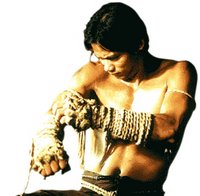
Sanuk, a Thai term usually translated as “Fun,” is a much-valued pursuit and covers a wide range of activities. Prominent among them are various traditional sports that despite such innovations as
Western football and bowling have never lost their appeal to the vest majority of Thais, especially in rural areas. During leisure time, almost any open field or festival offers a display of some kind, from the balletic ferocity of Thai-style boxing to more esoteric amusements such as a struggle between two giant horned beetles or multicolored Siamese fighting fish.
National Sports Museum
A collection of sports medals and torches are kept in the National Sports Museum located at the main hall of the west wing of Rajamangala National Stadium, Bangkok.
Exhibit Presentation
The area of exhibition is divided into 9 parts as follows:
1. Reception Hall
2. Evolution of International Sports in Thailand
3. Sports Organizations
4. Sportsmen’s Hall of Fame
5. Thailand National Sports Associations and Traditional Games
6. Hall of Fame
7. Prince Birabongse Bhanudej
8. The Royalty and Sporting Activities
9. His Majesty the King and Sports
Website: www.sat.or.th
Thai Boxing (Muay Thai)
In modern Thai-Style boxing, gloves are used but in most other ways it is similar to the sport of the past. Any part of the body, except the head, can be used as an offensive weapon. Some professional matches give rise to a fair amount of betting. This very popular sport is now practiced all over the world.
Muay Thai Stadium (Boxing Stadium)
Lumpinee Stadium
Located on Rama IV Road
Open every Tuesday and Friday, Time 06.00 - 10.00 p.m. and Saturday, Time 05.00-00.30 a.m.
Tel: 02-251-4303 and 02-280-4550
Ratchadamnoen Stadium
Located on Ratchadamnoen Nok Avenue (next to TAT)
Open every Monday, Wednesday at 06.00 p.m., Thursday at 05.00 p.m. and 09.00 p.m., Sunday at 04.00 p.m. and 08.00 p.m.
Tel: 02-281-4202 and 02-281-0879
The Martial Arts
As this old illustrated manuscript shows, boxing was an important part of self-defense. In the old days, no gloves were used and both hand and feet were bound in cloth that often constrained bits of ground glass for added effect. Several
Ayutthaya kings were famed for their skill in this graceful yet lethal art.
Takraw
In its traditional form, the game of takraw, which is also popular in neighboring countries such as Malaysia, involves keeping a hollow rattan ball aloft as long as possible. The circle of players can used their feet, knees, elbows and head but not their hands. Group of young men start a casual takraw game almost anywhere during a break from work or school, demonstrating remarkable grace and footwork.
Professional “Takraw”
Over the years, more professional forms of takraw have evolved, using nets to separate opposing teams or high baskets through which the ball must be sent, along with strict rules of play. Takraw competitions of this kind are often held in Bangkok at Sanam Luang and also at the Asian Games. The sport has been as Olympic event since the Atlanta Games.
“Chula” Kites
The detail above, from an old mural printing, show a chula, or “male”, kite caught in a temple roof. On breezy afternoons during the hot season, kites of all kinds can be seen in the sky above Sanam Luang, the great oval field across from the gold spires of the Grand Palace.
Kite-Fighting
Kite-fights in Thailand are actually a symbolic battle of the sexes. The “Female” is a small diamond shaped kite called a pukpao, while the “male”, called a chula, is a huge star-shaped creation that requires teams of up to seventy men to send it aloft and maneuver it. The object is for one of the chula to snare a pukpao with a bamboo hook and bring it down in “male” territory; alternatively, the more agile pukpao often succeed in looping their lines around a chula and bring it crashing it crashing to earth on their side of the field.
Beetle Battles
The large male horned beetle, commonly found in the Thai countryside, becomes aggressive when confronted by another member of his sex in the presence of a female. The ensuing battle, which ends when one of the contestants is overturned, is a popular spectator sport in villages, with wagers on the outcome.
Source from: Thailand A Traveller's Companion Book
 Sanuk, a Thai term usually translated as “Fun,” is a much-valued pursuit and covers a wide range of activities. Prominent among them are various traditional sports that despite such innovations as Western football and bowling have never lost their appeal to the vest majority of Thais, especially in rural areas. During leisure time, almost any open field or festival offers a display of some kind, from the balletic ferocity of Thai-style boxing to more esoteric amusements such as a struggle between two giant horned beetles or multicolored Siamese fighting fish.
Sanuk, a Thai term usually translated as “Fun,” is a much-valued pursuit and covers a wide range of activities. Prominent among them are various traditional sports that despite such innovations as Western football and bowling have never lost their appeal to the vest majority of Thais, especially in rural areas. During leisure time, almost any open field or festival offers a display of some kind, from the balletic ferocity of Thai-style boxing to more esoteric amusements such as a struggle between two giant horned beetles or multicolored Siamese fighting fish.


































0 Comments:
Post a Comment
<< Home